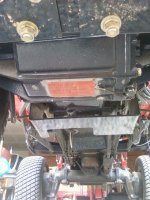Phillip w
Platinum Member
- Joined
- Jun 21, 2017
- Messages
- 776
- Location
- whiting ks
- Tractor
- allis Chalmers 185 and massey ferguson 1531
1500 rpm ??? Seems a little fast to me. You got cold oil. I set mine and always have tractors, semis etc at about 1000-1200 rpms and let it warm slowly. The shop foreman used to recommend 1100 rpms on them Cummins and Detroit engines for a cold start with semis. My dad has a duramax diesel pickup. The computer automatically set the engine speed at 1100 rpms on a cold start. Once it warms up the computer slows it down to about 800-900 rpms.I have the GC1720. For starters (sorry about that pun) it sounds like it is turning over a bit slow. Instead of the heating lamp, you may want to put a battery tender on it so you have full cold cranking amps when you need to start it. Run the glow plugs for 30 seconds (with the battery tender attached). Then open the throttle as was previously mentioned before turning the key. It should crank faster/harder and with a bit more fuel to work with, it should fire off.
Once it starts, set the RPMs to 1500 (not idle) and let it warm. You could also install a half to 3/4 height sheet of cardboard/plastic to block up part of the radiator (where the debris screen is) which will allow it to warm faster. At those external temps, you won't be hurting the engine by allowing the block to warm up better/faster without that cold air being drawn across the radiator.
Some folks will also engage the PTO (at the low RPMs, not work RPMs) so that all of the hydraulic fluid can start to circulate and warm. This isn't considered the 'working' that is cautioned against in the manual. You wouldn't want to fire up and immediately go to 3000 RPMs and start running a 540 RPM snowblower attachment or go plowing with the hydrostatic. Grab a cup of coffee.
Once the tractor is warm, disengage PTO and slowly run your hydraulics (loader/ 3-point) through all of its positions to allow the now warm hydro to replace the still frosty fluid in your cylinders.
Go to work.
As for block the radiator??? I've done this myself. I have use cardboard with some success. I vote a no go on plastic. You have got to have a little air moving through the raviator to prevent over heating. Plastic can prevent enough air flow and cause it to run hot even in sub-zero temps. I personally tried plastic and it didn't work out. Stay with cardboard. But, you have a thermostat and it's job is to control and regulate the engine temperature. On these little masseys, the engine is so "boxed in" that you really should not need to block of the radiator. Alot of heat gets trapped under the hood. At least that is the way my mf 1531 is. Now, on these bigger older farm tractors??? That is different. For straters they generally have a 5+ gallon coolant capacity, large thick brass radiators and the engine is totally exposed on both side. The heat does not get "trapped " under the hood. So yeah, blocking the radiator with cardboard makes sense. That is just my thoughts and expierence.
